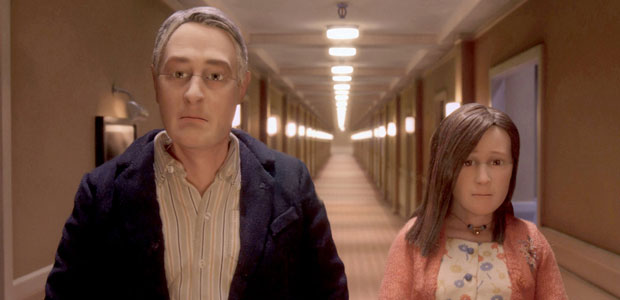The idea of “normal” presents one of the greatest struggles when it comes to identity. We’re all packaged with different DNA, different upbringings, different experiences, and different impulses, yet feel driven to live what appear to be the standard lives of the people around us. And then, of course, when we feel boxed in by that standard reality, we have the compulsion to break free of it. It’s the back and forth that every single one of us have experienced throughout our lives, even as that idea of “normal” has remained completely undefined and subjective. It’s a complex idea to fully explore in words, let alone a feature-length narrative starring stop-motion armatures, but leave it to brilliant writer/director Charlie Kaufman to do just that with the beautiful, deep, cerebral and poetic Anomalisa.
From beginning to end, there probably isn’t a film all year as simple as Kaufman’s movie, but there are few as spellbinding or engaging. Based on a play of the same name written by the writer/director, the movie stars David Thewlis as the voice of Michael Stone - the author of a book on the subject of customer service who is going through an emotional crisis during a business trip to Cincinnati to speak at a conference. Staying in a hotel, the guy is ready to all but completely lose it when, by accident, he happens to meet Lisa Hesselman (Jennifer Jason-Leigh), a shy young woman with a scarred face in which Michael happens to see ultimate beauty. Over the course of a single night, the man and woman begin to connect, both of them believing in the possibility of a different life alongside each other. And because it’s a movie that’s better left seen than described, that’s where my vague description of the plot will end.
Given Kaufman’s propensity for crafting dense work that maintains subtext in every moment, his movies do encourage a certain extra level of attention to be paid for subconscious dissection and analysis. But this is no effort for Anomalisa, which enraptures the audience from the very first moment – as random conversations are heard, which slowly pile on top of each other while the screen remains black. The writer/director’s sharp sense of humor is certainly an important tool in this regard, as an early scene in a taxi is completely disarming and features multiple big laughs, but what ultimately makes the film so compelling is a captivation in Michael Stone that develops out of an empathetic connection. The weight of the ennui floating in this character is carried in his slumped shoulders and heavy head, and he not only feels trapped, but also has no idea what is the key to his possible escape.
Michael and Lisa are each caught in the clutches of their own identity issues, as the former struggles to find something beyond the monotony and sameness that have invaded and infested his life; and the latter – a fan who has traveled a long way to hear Michael speak - has grown depressingly comfortable in being an outsider and feeling like an anomaly (I’ll leave it to you to piece together the film’s title). Their connection together is both a beautiful and fascinating one, but it’s also perfectly grounded in reality – making the stakes and emotions feel real, and their relationship organic. The characters are arguably using each other, their positions at opposite ends of the identity-crisis spectrum, and that lack of fantasy just makes their journey together more impactful.
Of course, the film also represents a hop into a new medium for Charlie Kaufman, who worked alongside co-director Duke Johnson to make Anomalisa as his first stop-motion animated movie – and it’s another genius choice by the filmmaker, as the approach harmonizes perfectly with the story being told and the ideas being explored. Stylistically accentuating the isolation of Michael and Lisa in this world, every other character not only has the same face (with different hair and bodies), but also is voiced by Tom Noonan (working out a variety of different inflections and pitches to at least partially individualize each person). Given the way the animation style now uses removable face plates – evident in the bold line across the eyes and bridge of the nose of every figure – stop-motion just poetically fits with everything being said. It’s also easy to just marvel at the work done by Starburns Industries and their attention to detail, both in character and production design, for Anomalisa.
Fans of Charlie Kaufman’s work have had to wait seven years for the filmmaker to return to the big screen, his last movie and directorial debut being 2008’s devastating and incredible Synecdoche, New York. While we pray that he won’t make us wait that long for his next feature, the staggering brilliance of Anomalisa is a reminder that we can continue to expect works of incredible insight and power that help change the way we look at our world and all of us swimming around in it.

Eric Eisenberg is the Assistant Managing Editor at CinemaBlend. After graduating Boston University and earning a bachelor’s degree in journalism, he took a part-time job as a staff writer for CinemaBlend, and after six months was offered the opportunity to move to Los Angeles and take on a newly created West Coast Editor position. Over a decade later, he's continuing to advance his interests and expertise. In addition to conducting filmmaker interviews and contributing to the news and feature content of the site, Eric also oversees the Movie Reviews section, writes the the weekend box office report (published Sundays), and is the site's resident Stephen King expert. He has two King-related columns.











